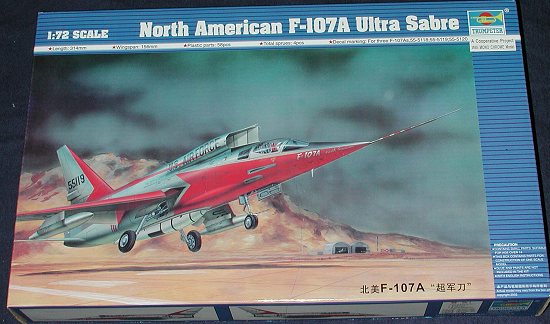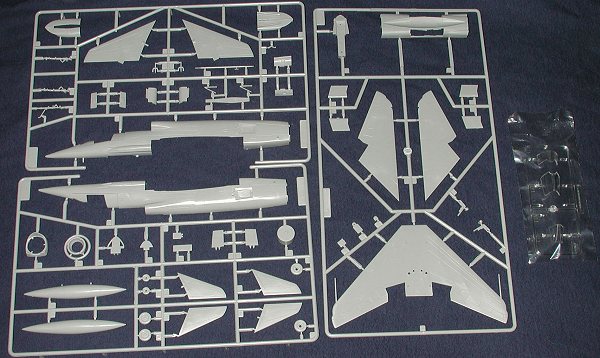
| KIT: | Trumpeter 1/72 F-107A |
| KIT # | 1605 |
| PRICE: | $16.95 |
| DECALS: | All of the three prototypes |
| REVIEWER: | |
| NOTES: |

| HISTORY |
The F-107 was initially a redesign of the F-100 Super Sabre series. You can see the similarity in the designs by looking at the wings and tail planes. It was to be called the F-100B (probably a funding thing again), but by the time the design was well underway, it was pretty obvious that this wasn't going to be much like the F-100 at all. The aircraft was designed around the new J-75 turbojet and was to have a top speed of mach 2.3. It was also designed to do mach 1 + while flying straight up. The reason for the position of the intake was to have the best airflow possible for the engine.
Controls were not by ailerons, but by upper and lower wing spoilers. An indentation on the center fuselage was to allow it to carry large 'special stores' or a fuel tank. Four wing hardpoints were built into the design. For offensive capabilities, four 20mm cannon were mounted in its pointed nose.
Three prototypes were ordered in 1953 with a follow-up order for six pre-production aircraft. The mockup was examined and accepted in July of 1954. In order to have a requirement for the F-107 and F-105, a set was designed around the capabilities of these two planes in December of 1954. Detail design of the prototypes stared in May of 1955 with the first prototype leaving the factory in August of 1956, a mere 15 months later. First flight was in September of 1956. The F-105 had been flying for 11 months at this time. The second prototype flew in November of 1956. The next month a fly-off competition between it and the F-105 began. The F-105 was determined to be the winner and the other 6 preproduction F-107s were cancelled the next month.
The third prototype flew in February of 1957 under the controls of Al White, one of North American's best pilots. The next month the entire F-107 program was cancelled by the USAF, even though the three prototypes were still being flown by NAA and the USAF. In November 1957, two of the aircraft were turned over to NASA for high speed flight research. The other was sent to the USAF Museum in Dayton, only a year after it had first flown. The remaining two were tested for three years. During that time one crashed and declared unsalvageable. The other F-107A eventually made it to the Pima Air Museum in Tucson where it remains today. The F-107 was the last fighter to be built by North American Aviation.
| THE KIT |

When I saw this kit in the local hobby shop, I nearly broke my hand pulling out my wallet. I've been waiting for this kit with much anticipation. According to the box top, this is a "Cooperative project with Mono Chrome Model". Well, I'm not sure who that other company is, but I'm mightily impressed with the kit as it comes in the box. As you know, the real test of a new kit comes with building, but previews such as this are a help. First of all it is the standard engraved panel lines as one expects with new kits. The surface of the plastic is a bit matte but without the 'pebbly' surface that some of these kits have had. The detailing itself is quite crisp without the 'soft' edges than can be found.
I did a pretty thorough search for sink marks, flash and ejector pin marks. I only found sink areas on the wings where there were large alignment pins and on one other part. Both seem easy to repair. Ejector pin marks were all on the inside of things. The only ones that may cause concern would be those inside the intake. As for flash, I found none.
The kit itself has an adequate cockpit with a tub, control stick, 5-piece bang seat, and instrument panel. The panel has some instrument detail but the consoles have none. No decal is provided for instruments. The lower section of the cockpit tub is the nose gear well and has no detailing at all. Same with the main gear wells regarding detail. In fact, the main gear attaches to holes in the lower wing which forms the upper gear well. The exhaust area is nicely done in three pieces which is a rather complicated deal. Engine exhaust detail is minimal.
Probably the most unusual aspect of this kit for me is that the fin and tail planes are two pieces. It would have seemed to me that these items would have been better done as a single mold as they are relatively thin. They will need some small clean up of flash from the ejector pin marks prior to cementing. The only real options are to have the speed brakes open or closed and this is the same with the canopy.
 The instructions are like most of the Trumpeter kits I've seen and should do well. Colors needed are provided in generic terms and no references to FS standards or paint lines are given. The decals are very crisply printed and glossy. I'm not sure how well they'll work, but given the slim chances of aftermarket, I can only hope they will do well. There are markings for the three prototypes but only two of them are shown on the decal placement guild. They were basically marked the same and of course, the builder will have to mask and paint the gloss red areas. There are NASA tail bands on the sheet, but nothing in the markings guide about them at all.
The instructions are like most of the Trumpeter kits I've seen and should do well. Colors needed are provided in generic terms and no references to FS standards or paint lines are given. The decals are very crisply printed and glossy. I'm not sure how well they'll work, but given the slim chances of aftermarket, I can only hope they will do well. There are markings for the three prototypes but only two of them are shown on the decal placement guild. They were basically marked the same and of course, the builder will have to mask and paint the gloss red areas. There are NASA tail bands on the sheet, but nothing in the markings guide about them at all.
| CONCLUSIONS |
Just from a quick once over, it seems as if this kit will be a winner with the buying public. The 'What If' crowd can go nuts on this one. For those wanting a bit of aftermarket, Aeroclub makes an F-100 bang seat that should be about the same as what's in this plane. In addition to the references mentioned below, there is a Ginter book on this plane that should provide more than enough info to do the plane of your choice. Hey, it's only another $15-20!
| REFERENCES |
Supersonic Cavaliers by Steve Pace. Airpower Vol 16/6, November 1986
If you would like your product reviewed fairly and fairly quickly by asite that has well over 175,000 visitors a month, please contactme or see other details in the